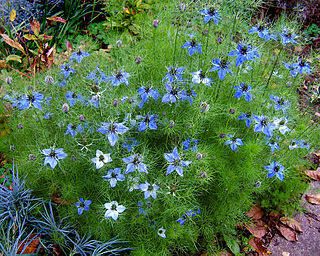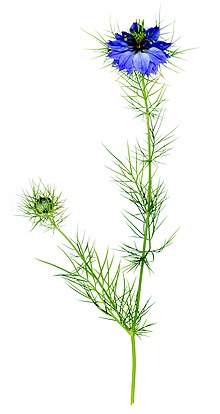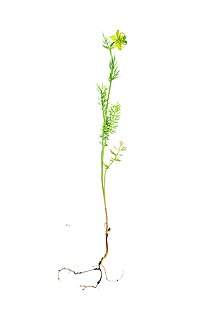
Ajwain or ajowan —also known as ajowan caraway, omam , thymol seeds, bishop's weed, or carom—is an annual herb in the family Apiaceae. Both the leaves and the seed‑like fruit of the plant are consumed by humans. The name "bishop's weed" also is a common name for other plants. The "seed" is often confused with lovage seed.
Lactucarium is the milky fluid secreted by several species of lettuce, especially Lactuca virosa, usually from the base of the stems. It is known as lettuce opium because of its sedative and analgesic properties. It has also been reported to promote a mild sensation of euphoria. Because it is a latex, lactucarium physically resembles opium, in that it is excreted as a white fluid and can be reduced to a thick smokable solid.

Cannabis sativa is an annual herbaceous flowering plant. The species was first classified by Carl Linnaeus in 1753. The specific epithet sativa means 'cultivated'. Indigenous to Eastern Asia, the plant is now of cosmopolitan distribution due to widespread cultivation. It has been cultivated throughout recorded history and used as a source of industrial fiber, seed oil, food, and medicine. It is also used as a recreation drug and for religious and spiritual purposes.

Nigella damascena, love-in-a-mist, or devil in the bush, is an annual garden flowering plant, belonging to the buttercup family Ranunculaceae. It is native to southern Europe, north Africa and southwest Asia, where it is found on neglected, damp patches of land.

Indazole, also called isoindazole, is a heterocyclic aromatic organic compound. This bicyclic compound consists of the fusion of benzene and pyrazole.
A carminative, known in Latin as carminativum, is a herb or preparation intended to either prevent formation of gas in the gastrointestinal tract or facilitate the expulsion of gas from the gastrointestinal tract, thereby combatting flatulence.

Nigella sativa is an annual flowering plant in the family Ranunculaceae, native to eastern Europe and western Asia, but naturalized over a much wider area, including parts of Europe, northern Africa and east to Myanmar. It is used as a spice in many cuisines.
The vitamin E family comprises four tocotrienols and four tocopherols. The critical chemical structural difference between tocotrienols and tocopherols is that tocotrienols have unsaturated isoprenoid side chains with three carbon-carbon double bonds versus saturated side chains for tocopherols.
Carvacrol, or cymophenol, C6H3(CH3)(OH)C3H7, is a monoterpenoid phenol. It has a characteristic pungent, warm odor of oregano.

Caryophyllene, more formally (−)-β-caryophyllene (BCP), is a natural bicyclic sesquiterpene that is a constituent of many essential oils, especially clove oil, the oil from the stems and flowers of Syzygium aromaticum (cloves), the essential oil of Cannabis sativa, copaiba, rosemary, and hops. It is usually found as a mixture with isocaryophyllene and α-humulene, a ring-opened isomer. Caryophyllene is notable for having a cyclobutane ring, as well as a trans-double bond in a 9-membered ring, both rarities in nature.

α-Pinene is an organic compound of the terpene class. It is one of the two isomers of pinene, the other being β-pinene. An alkene, it contains a reactive four-membered ring. It is found in the oils of many species of many coniferous trees, notably the Pinus and Picea species. It is also found in the essential oil of rosemary and Satureja myrtifolia. Both enantiomers are known in nature; (1S,5S)- or (−)-α-pinene is more common in European pines, whereas the (1R,5R)- or (+)-α-isomer is more common in North America. The enantiomers' racemic mixture is present in some oils such as eucalyptus oil and orange peel oil.
A TNF inhibitor is a pharmaceutical drug that suppresses the physiologic response to tumor necrosis factor (TNF), which is part of the inflammatory response. TNF is involved in autoimmune and immune-mediated disorders such as rheumatoid arthritis, ankylosing spondylitis, inflammatory bowel disease, psoriasis, hidradenitis suppurativa and refractory asthma, so TNF inhibitors may be used in their treatment. The important side effects of TNF inhibitors include lymphomas, infections, congestive heart failure, demyelinating disease, a lupus-like syndrome, induction of auto-antibodies, injection site reactions, and systemic side effects.

Thymoquinone is a phytochemical compound found in the plant Nigella sativa. It is also found in select cultivated Monarda fistulosa plants which can be steam distilled to produce an essential oil.
In Islam, prophetic medicine is the advice regarding sickness, treatment and hygiene based on reports of the Islamic prophet Muhammad as found in the hadith. The therapy involves diet, bloodletting, and cautery, and simple drugs, numerous prayers and pious invocations for the patient to perform, but no surgery. Maladies discussed include fevers, plague, leprosy, poisonous bites, protection from night-flying insects and the evil eye, rules for coitus, theories of embryology, etc. The authors of its manuals were religious clerics who collected and explicated these traditions, not physicians, and it is usually practiced by non-physicians. How much of the medicine is divine revelation and how much folk practices inherited from ancestors is disputed.

Cumin is a flowering plant in the family Apiaceae, native to the Irano-Turanian Region. Its seeds – each one contained within a fruit, which is dried – are used in the cuisines of many cultures in both whole and ground form. Although cumin is used in traditional medicine, there is no high-quality evidence that it is safe or effective as a therapeutic agent.

α-Hederin (alpha-hederin) is a water-soluble pentacyclic triterpenoid saponin found in the seeds of Nigella sativa and leaves of Hedera helix.

The history of spices reach back thousands of years, dating back to the 8th century B.C. Spices are widely known to be developed and discovered in Asian civilizations. Spices have been used in a variety of antique developments for their unique qualities. There were a variety of spices that were used for common purposes across the ancient world. Different spices hold a value that can create a variety of products designed to enhance or suppress certain taste and/or sensations. Spices were also associated with certain rituals to perpetuate a superstition or fulfill a religious obligation, among other things.

The flora of Nepal is one of the richest in the world due to the diverse climate, topology and geography of the country. Research undertaken in the late 1970s and early 1980s documented 5067 species of which 5041 were angiosperms and the remaining 26 species were gymnosperms. The Terai area has hardwood, bamboo, palm, and sal trees. Notable plants include the garden angelica, Luculia gratissima, Meconopsis villosa, and Persicaria affinis. However, according to ICOMOS checklist, in the protected sites, there are 2,532 species of vascular plants under 1,034 genera and 199 families. The variation in figures is attributed to inadequate floral coverage filed studies. Some of the plants contain medicinal values. It contains certain chemical which is used to heal wound by There are 400 species of vascular plants which are endemic to Nepal. Of these, two in particular are orchids Pleione coronaria and Oreorchis porphyranthes. The most popular endemic plant of Nepal is rhododendron (arboreum) which in Nepali language is called lali guras.

Cannabitriol ((+)-CBT, (S,S)-9,10-Dihydroxy-Δ6a(10a)-THC) is a phytocannabinoid first isolated in 1966, an oxidation product of tetrahydrocannabinol which has been identified both as a trace component of cannabis and as a metabolite in cannabis users. Its pharmacology has been little studied, though it has been found to act as an antiestrogen and aromatase inhibitor.





















